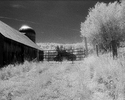Hello
I've encountered a rather strange thing on my latest roll of film. It's a 35 mm Kodak Tri-X expired back in 2011. I shot it at EI320 and developed in homemade D-76 developer which I made according to the instructions. I used 1+1 dilution, developed for 9 minutes at 21 degrees Celsius. Whole roll developed evenly and without any other unwanted surprises. Except for one. This is a sample:

And this is a 100% crop of the same picture:

Whole roll has the same little black things all over it. It's not what Tri-X photos look like on the internet so I must be doing something wrong. Can anyone point at the problem?
Thank you.
M.
I've encountered a rather strange thing on my latest roll of film. It's a 35 mm Kodak Tri-X expired back in 2011. I shot it at EI320 and developed in homemade D-76 developer which I made according to the instructions. I used 1+1 dilution, developed for 9 minutes at 21 degrees Celsius. Whole roll developed evenly and without any other unwanted surprises. Except for one. This is a sample:

And this is a 100% crop of the same picture:

Whole roll has the same little black things all over it. It's not what Tri-X photos look like on the internet so I must be doing something wrong. Can anyone point at the problem?
Thank you.
M.









